All
the |
(Navigation bar
directly below.)
*******
© A.J. Goldsby, 2015.
(All rights reserved.)
****************
Click HERE
to see my
Chess Items.
****************
****************
Buy a book
from Amazon.com
(And help me out as well!)
****************
Click HERE
...
to see a list of the businesses that help to sponsor all of
my chess efforts.

"The King" In Chess
The King
(Or "Its good to be King!!")
Click HERE to return to my Training Page.
Click HERE to return to my HOME Page.
Click HERE to go to another site where the basics of chess are covered.
Click HERE to go to another site where the basics of how the pieces move are covered.
***
The King is the most important
piece on the chess-board! ***
If you lose your King, (I.e., get "Checkmated."); the game is OVER!!
No
second chances!
Some of the basic properties of the King are:
-
- You must guard and protect your King constantly and always be aware your opponent
will do anything ... even give away great quantities of material ... to mate your King
and win the game.
-
- The King can become a powerful piece, especially in the endgame.
-
- An active King in the endgame can be nearly as dangerous as an enemy Rook.
-
- But you still have to be on guard against a surprise check-mate.
-
- King safety is of paramount importance. (Many consider it a basic element of the game.)
Most of the time, especially when there are a lot of pieces on the board, your King should be safely tucked away in the corner.
Its only when a lot of the pieces come off or are exchanged, that the King becomes a weapon in his own right.
Look carefully at the diagram below. It shows, very
graphically,
the movement ability of the White (or Black) King.
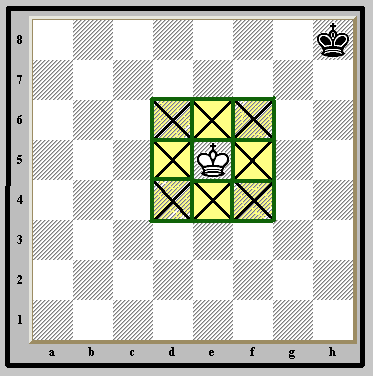
In the picture/diagram above,
The White King, (or the Black King;)
can move one square in any direction.
The King is the captain [leader/supreme ruler] of the army. The King is
a very simple piece to remember.
---> It may move ONE SQUARE
in
any direction.
(Note the similarity to the White Queen. She moves also in any direction, but moves as many squares as she likes in a straight line.)
Think of the King as a "mini-Queen." Their movement powers are
very broad and unfettered, (Royal Power); although the Queen is clearly the more
powerful of the two pieces!
[ Remember: The King and Queen stand in the middle of the board at the start of the game.]
The above diagram shows the potential movement of the White King. The King may move to any of the squares marked by an "X," and highlighted in yellow. The King could also capture any piece that landed on any of those squares. (As long as it was not protected by any other piece.)
(I use a Rook in the examples below. A Rook moves in a straight line, up and down, or back and forth.)
Now look at the diagram below. The Black King is cut off by the White Rook.
![(The Black King thinks out loud ...) "One step to the right, [e-file] and I'm history!"](the_king_cm1.gif)
(Glance at the above diagram again, and fix it firmly in your mind.)
The King can NEVER move into check. This is to say that the
King can never move into a square that is [threatened/controlled]
by the CAPTURING POWER of an enemy piece.
In the above picture, the Black King (on d6) may not move into the capturing power of the White Rook, (on e1). These squares, that the Black King cannot touch, are marked by the large "X's."
Think of the White Rook as projecting a force field down the board, from e1 to e8. The King may not (willingly) touch the squares under any circumstances. Like an electrified fence, as soon as the King touches one of these squares ... HE DIES!!
(Moving to a square controlled by an enemy piece is known as, "Moving into CHECK, and is an ILLEGAL move." Illegal = not allowed by the rules of chess. Many chess servers and chess programs will not allow you to make an illegal move. If your chess program does not allow a move, check it. It may be you are trying to make an illegal move.)
Any square that is controlled by an enemy piece is off-limits to your King.
(As long as the piece controls a certain square,
your King cannot move there.
But if the piece moves away and no
longer control a certain square, then your
King could feel free to travel to
that square, perhaps on the next move.)
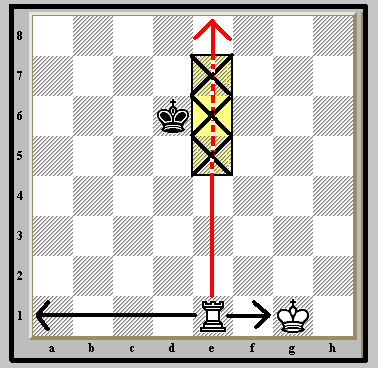
Take a good look at the above diagram. I have added some arrows to the diagram that preceded this one, to demonstrate the movement power of the White Rook on e1.
The Rook could move to any of the squares marked by the arrows.
(The Rook could NOT go to g1. This square is already occupied by the White King. And no, you may not capture your own piece. The White Rook on e1 also MAY NOT move to the h1-square. The ONLY piece that can "jump over" other pieces is the Knight.)
***
To summarize, The King may move or capture any piece one square ...
IN ANY DIRECTION.
The King may NEVER move into check, i.e., a square that is controlled by an enemy piece.
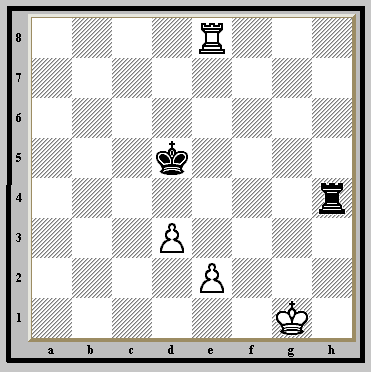
Take a good look at the above picture or diagram. It is White to move.
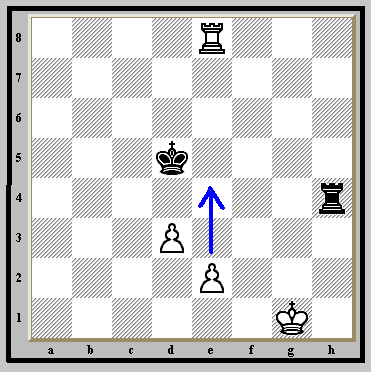
Now look at the diagram again. It is White's turn to move. He plays 1. e2-e4+. (Notice the blue arrow that I have added.) This is to say that he moves the Pawn at e2 to the square, e4. It is check to the Black King on d5, as he is now in the capturing power of the pawn on e4.
(It is customary, but NOT required, to announce check, by saying, "Check!")
Black plays 1...Rxe4. (??) This is a mistake that many beginners make.
White responds 2. RxR/e4.
(The White Rook on e8 captures the Black Rook on e4.)
This leaves us with the position below.
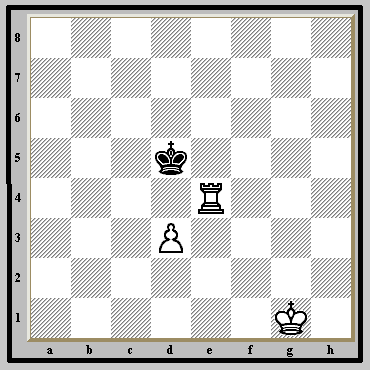
Black CAN
NOT legally capture the Rook on e4,
as he would then
be in check from the pawn on d3.
Since White has a Rook and a pawn more than his opponent, he would win easily.
This concludes our basic beginner's lesson on how the King moves.
(See the top of the page for the basic properties of the KING.)
***
Copyright (c) LM A.J. Goldsby I
Copyright (c) A.J. Goldsby, 1975-2014.
Copyright © A.J. Goldsby, 2015. All rights reserved.
***
(Page last update: Sunday; February 22nd, 2004. Last edit or save on: 02/12/2015 .)
Click HERE
to go to the next page in
my
beginner's course.
It is called: "The Queen" in Chess.